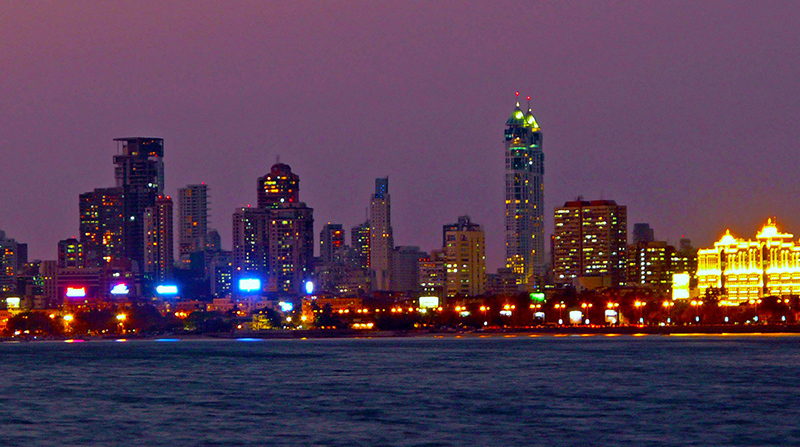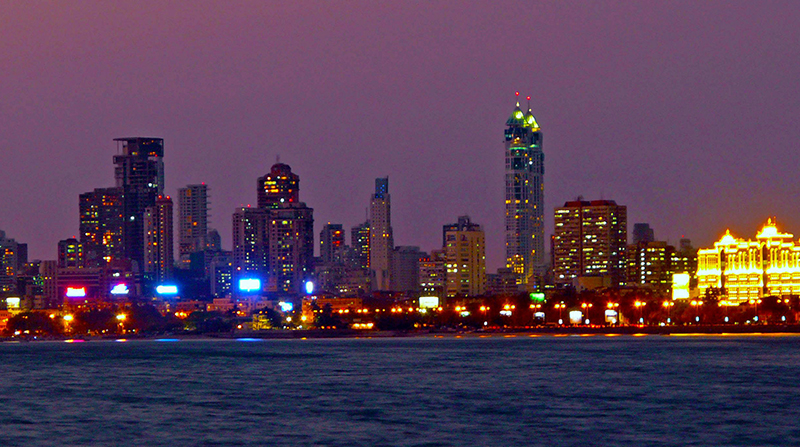

Mumbai skyline at night, Photo Credit: Cididity Hat
The city may not be traditional in the sense of ancient temples and camel bazaars, but Mumbai represents the heady, chaotic face of 21st-century India with its Bollywood glamour, fabulous street food and old-meets-new vibe.
Languages spoken in Mumbai
Both English and Hindi are spoken widely throughout India and most people understand at least some of either language, or a blend of both known as “Hinglish.” Marathi is the official language of Mumbai and the state of Maharashtra.
If you’re just frequenting the popular tourist spots, you should be able to get by speaking only English, but it always goes a long way with a local if you can say a few words in either Hindi or Marathi.
The best time to visit Mumbai
You’ll experience the best weather in Mumbai between October and March. During this time, the air is dry and temperatures hover around 86 degrees Fahrenheit, providing the perfect weather for outdoor events like enjoying sundowners at an open-air bar or experiencing the carnival atmosphere at Chowpatty Beach.
You could also plan your visit around the flurry of festivals that occur throughout the year. In the winter, for example, the city hosts many food- and art-focused events, including the Mumbai International Film Festival, the Kala Ghoda Arts Festival and the Taste of Mumbai.
What to pack for a trip to Mumbai
If you are visiting during the winter (between October and February), you will need light, comfortable clothes for temperatures that can reach the 80- to 90-degree range. It can occasionally get a little chilly in the evening, so be sure to bring a light shawl or sweater with you.
Monsoon season runs from June to September, so if you plan to come during the summer, be prepared. Be sure to pack waterproof shoes — Mumbai’s streets don’t have great drainage and are prone to flooding. An umbrella and a raincoat or light jacket are also helpful.
Some things to know before visiting Mumbai
While Mumbai is a modern city, it is still very easy to get sick from the food and water here. The most important thing to remember is to keep yourself healthy. Never drink the water from the tap, even if you see locals doing it — stick to bottled mineral water everywhere.
When it comes to meals, you should be safe eating in large hotels and clean, sit-down restaurants. If you want to try some of Mumbai’s fabulous street food, it’s best to go for hot dishes that are cooked in front of you. Steer clear of anything that has been sitting around for long periods of time or cut fruit that may have been rinsed in tap water.
Even though it may be hot and Mumbai is quite modern, it’s advised to wear modest clothing. Treat yourself to a unique souvenir and buy a colorful cotton kurta — this traditional outfit is perfect for the humid climate and will help you look like a local.
Seeing poverty is unavoidable in Mumbai. There are millions of people who are either homeless or live in slums, which are everywhere, even in the poshest of suburbs. You will no doubt experience beggars while walking down the street — just be sure to think about whether you wish to give money or not before being faced with the situation.
Should visitors rent a car in Mumbai?
While it is possible to rent a car here, it’s not recommended. Driving in Mumbai is guided by a subtle set of ambiguous rules that are based on experience and a sound understanding of what each particular “honk” means.
The road is shared with trucks, cars, autorickshaws, bicycles, pedestrians and even cows, with each having their own unwritten place in the traffic hierarchy. For someone who has never driven in India before, navigating Mumbai’s streets may be an intimidating and dangerous idea.
It is possible to hire a car with a driver for a day, and it is usually a more cost-effective and comfortable way to travel around the city than by autorickshaw or bus.
The only potential problem is Mumbai’s notorious traffic. Depending upon the time of day and your destination, it is not unusual to find yourself sitting in gridlock for more than two hours trying to get from one end of the city to another.
Tipping etiquette in Mumbai
To tip or not to tip is a delicate topic in Mumbai as everyone seems to have a different opinion. As a general rule of thumb, if you’re happy with the service, feel free to leave a little extra.
In a sit-down restaurant or bar, you will usually find a service charge on your bill of between 5 and 10 percent. Generally it is not necessary to leave an extra tip above the service charge unless you would like to. Just make sure you don’t confuse any government charges like “service tax” with the “service charge.”
If you eat somewhere that doesn’t have a service charge, it is customary to leave a gratuity of 5 to 10 percent or simply round up the bill.
It’s not mandatory to tip drivers, door staff or delivery people, but again, if you’re happy will their service, feel free to give them a few extra rupees.
